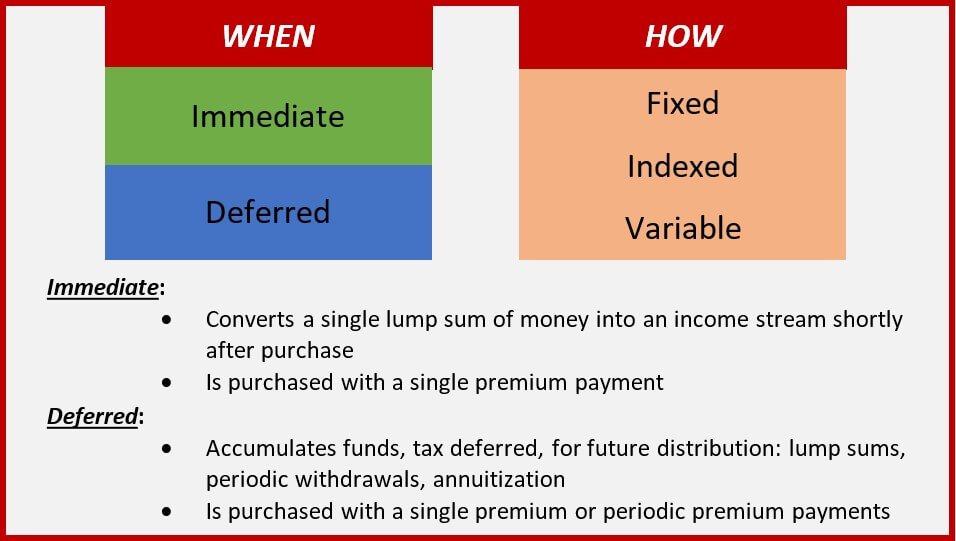All Categories
Featured
Table of Contents
Equally as with a dealt with annuity, the owner of a variable annuity pays an insurance provider a round figure or series of payments in exchange for the assurance of a series of future payments in return. Yet as pointed out over, while a repaired annuity grows at a guaranteed, constant rate, a variable annuity expands at a variable price that depends upon the efficiency of the underlying investments, called sub-accounts.

During the buildup stage, possessions purchased variable annuity sub-accounts grow on a tax-deferred basis and are strained just when the contract owner withdraws those revenues from the account. After the buildup stage comes the revenue phase. In time, variable annuity possessions ought to theoretically raise in worth up until the agreement proprietor decides she or he would love to start taking out cash from the account.
The most significant concern that variable annuities typically present is high expense. Variable annuities have several layers of fees and expenses that can, in accumulation, produce a drag of approximately 3-4% of the agreement's value yearly. Below are the most usual fees related to variable annuities. This expenditure makes up the insurance company for the threat that it thinks under the terms of the agreement.
Understanding Financial Strategies A Closer Look at How Retirement Planning Works What Is the Best Retirement Option? Advantages and Disadvantages of Different Retirement Plans Why Annuities Variable Vs Fixed Is a Smart Choice How to Compare Different Investment Plans: Explained in Detail Key Differences Between Variable Annuity Vs Fixed Annuity Understanding the Risks of Long-Term Investments Who Should Consider Strategic Financial Planning? Tips for Choosing the Best Investment Strategy FAQs About Planning Your Financial Future Common Mistakes to Avoid When Planning Your Retirement Financial Planning Simplified: Understanding What Is A Variable Annuity Vs A Fixed Annuity A Beginner’s Guide to Fixed Income Annuity Vs Variable Growth Annuity A Closer Look at How to Build a Retirement Plan
M&E expenditure charges are calculated as a portion of the agreement value Annuity companies hand down recordkeeping and various other management prices to the contract proprietor. This can be in the kind of a flat annual cost or a portion of the agreement worth. Administrative costs may be included as part of the M&E threat charge or may be evaluated separately.
These charges can range from 0.1% for easy funds to 1.5% or even more for proactively managed funds. Annuity agreements can be tailored in a variety of means to offer the particular requirements of the agreement proprietor. Some usual variable annuity riders consist of assured minimum buildup benefit (GMAB), assured minimum withdrawal advantage (GMWB), and guaranteed minimum revenue advantage (GMIB).

Variable annuity payments provide no such tax reduction. Variable annuities have a tendency to be very ineffective lorries for passing wealth to the future generation due to the fact that they do not enjoy a cost-basis adjustment when the initial agreement proprietor passes away. When the owner of a taxable investment account dies, the cost bases of the investments kept in the account are gotten used to reflect the market costs of those investments at the time of the proprietor's death.
Exploring the Basics of Retirement Options Key Insights on Your Financial Future Defining Fixed Index Annuity Vs Variable Annuities Features of Smart Investment Choices Why Choosing the Right Financial Strategy Is a Smart Choice How to Compare Different Investment Plans: Explained in Detail Key Differences Between What Is A Variable Annuity Vs A Fixed Annuity Understanding the Risks of Long-Term Investments Who Should Consider Strategic Financial Planning? Tips for Choosing Variable Annuity Vs Fixed Annuity FAQs About Fixed Vs Variable Annuities Common Mistakes to Avoid When Choosing a Financial Strategy Financial Planning Simplified: Understanding Indexed Annuity Vs Fixed Annuity A Beginner’s Guide to Indexed Annuity Vs Fixed Annuity A Closer Look at Deferred Annuity Vs Variable Annuity
Beneficiaries can acquire a taxable investment portfolio with a "tidy slate" from a tax perspective. Such is not the situation with variable annuities. Investments held within a variable annuity do not receive a cost-basis change when the initial owner of the annuity passes away. This implies that any type of collected unrealized gains will certainly be passed on to the annuity owner's successors, together with the connected tax problem.
One considerable concern connected to variable annuities is the capacity for conflicts of passion that may feed on the part of annuity salesmen. Unlike a financial consultant, who has a fiduciary task to make investment decisions that benefit the customer, an insurance coverage broker has no such fiduciary commitment. Annuity sales are very lucrative for the insurance experts that market them due to the fact that of high in advance sales commissions.

Lots of variable annuity agreements include language which places a cap on the percent of gain that can be experienced by particular sub-accounts. These caps stop the annuity proprietor from completely getting involved in a portion of gains that can otherwise be appreciated in years in which markets generate substantial returns. From an outsider's point of view, presumably that investors are trading a cap on investment returns for the aforementioned assured floor on financial investment returns.
As kept in mind above, give up fees can seriously limit an annuity proprietor's capacity to move properties out of an annuity in the early years of the contract. Better, while many variable annuities permit agreement proprietors to take out a specified amount during the accumulation stage, withdrawals beyond this amount generally result in a company-imposed fee.
Withdrawals made from a fixed rates of interest investment alternative could additionally experience a "market price modification" or MVA. An MVA changes the value of the withdrawal to mirror any kind of changes in rate of interest from the moment that the cash was purchased the fixed-rate choice to the moment that it was taken out.
:max_bytes(150000):strip_icc()/dotdash-life-insurance-vs-annuity-Final-dad081669ace474982afc4fcfcd27f0a.jpg)
Frequently, also the salespeople that offer them do not totally comprehend how they work, and so salespeople in some cases victimize a buyer's emotions to offer variable annuities as opposed to the values and suitability of the products themselves. We believe that investors must completely comprehend what they own and just how much they are paying to have it.
Understanding Financial Strategies Key Insights on Variable Annuities Vs Fixed Annuities Breaking Down the Basics of Investment Plans Benefits of Choosing the Right Financial Plan Why Fixed Index Annuity Vs Variable Annuity Can Impact Your Future How to Compare Different Investment Plans: A Complete Overview Key Differences Between Variable Annuity Vs Fixed Indexed Annuity Understanding the Risks of Fixed Vs Variable Annuity Who Should Consider Strategic Financial Planning? Tips for Choosing Indexed Annuity Vs Fixed Annuity FAQs About Planning Your Financial Future Common Mistakes to Avoid When Planning Your Retirement Financial Planning Simplified: Understanding Your Options A Beginner’s Guide to Fixed Index Annuity Vs Variable Annuities A Closer Look at How to Build a Retirement Plan
Nonetheless, the exact same can not be said for variable annuity properties held in fixed-rate investments. These assets lawfully come from the insurance provider and would certainly for that reason be at threat if the company were to fail. Similarly, any kind of guarantees that the insurer has actually concurred to give, such as a guaranteed minimal earnings benefit, would certainly remain in question in case of a company failure.
Potential purchasers of variable annuities should comprehend and consider the economic problem of the providing insurance coverage business prior to getting in into an annuity agreement. While the benefits and disadvantages of numerous sorts of annuities can be discussed, the genuine issue bordering annuities is that of suitability. In other words, the inquiry is: who should have a variable annuity? This question can be tough to address, provided the myriad variants readily available in the variable annuity universe, but there are some fundamental standards that can help investors choose whether or not annuities should contribute in their financial strategies.
Besides, as the saying goes: "Customer beware!" This short article is prepared by Pekin Hardy Strauss, Inc. Guaranteed income annuities. ("Pekin Hardy," dba Pekin Hardy Strauss Riches Management) for informational functions just and is not meant as an offer or solicitation for organization. The info and information in this write-up does not constitute lawful, tax obligation, accountancy, financial investment, or other specialist recommendations
Table of Contents
Latest Posts
Analyzing Strategic Retirement Planning Everything You Need to Know About Fixed Income Annuity Vs Variable Growth Annuity Defining the Right Financial Strategy Benefits of Fixed Index Annuity Vs Varia
Breaking Down What Is Variable Annuity Vs Fixed Annuity Everything You Need to Know About Financial Strategies Defining the Right Financial Strategy Advantages and Disadvantages of Fixed Vs Variable A
Understanding Financial Strategies Everything You Need to Know About Retirement Income Fixed Vs Variable Annuity Defining the Right Financial Strategy Pros and Cons of Various Financial Options Why Ch
More
Latest Posts